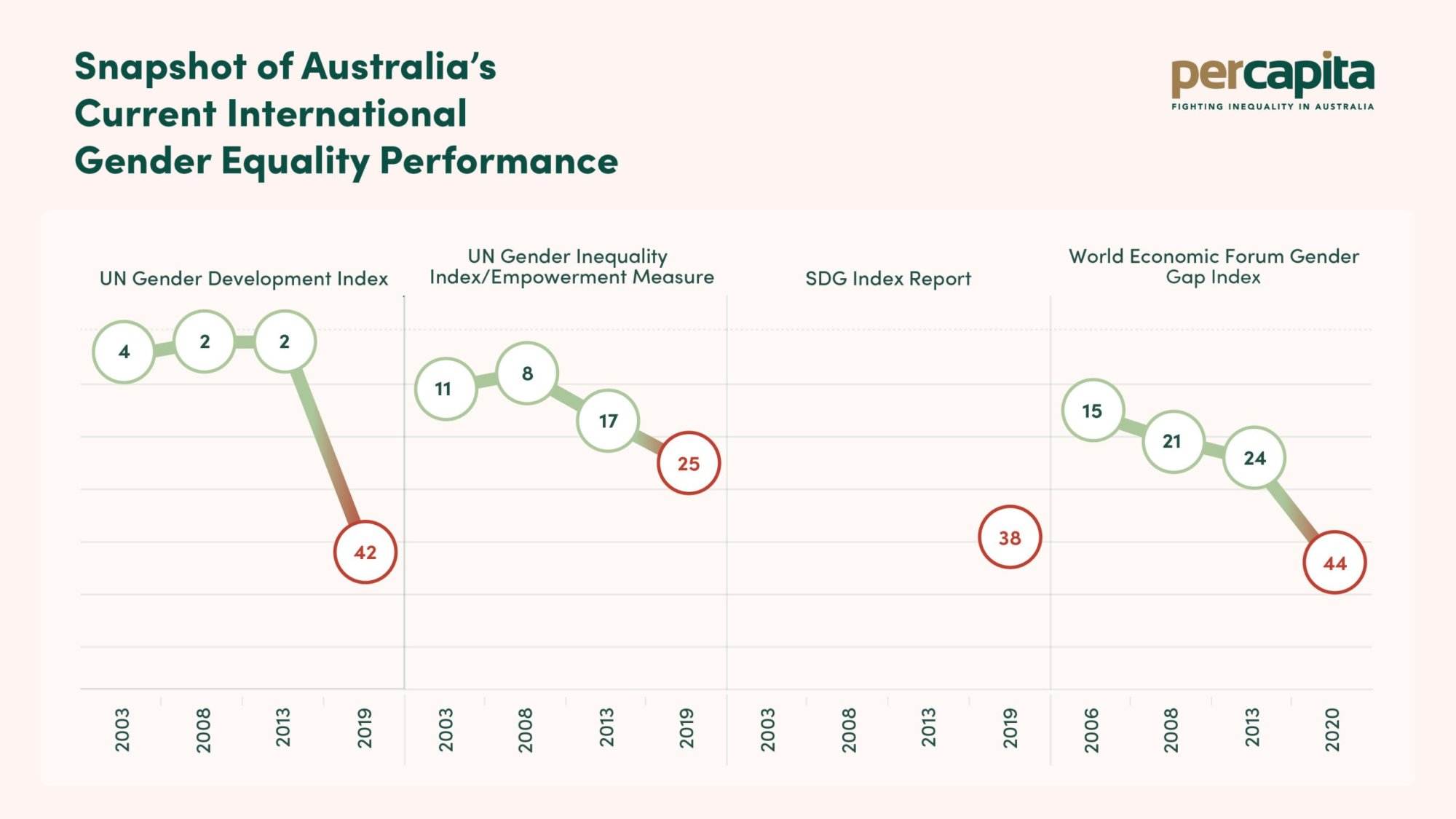Executive Summary
The World Economic Forum has, since 2006, produced an annual report to measure the global gender gap. The Global Gender Gap Index (GGGI) collects gendered data across four thematic areas: economic participation and opportunity, educational attainment, health and survival, and political empowerment.
Australia has dropped from a ranking of 15th in the world when the GGGI commenced to 44th in 2020 – a decline of 29 places in just 14 years.
Over the same time period, Australia’s commitment to measuring gender equality has been in retreat: 2006 was, for example, the year the federal government stopped funding the Australian Bureau of Statistics to undertake the Time Use Survey, which measured the hours of paid and unpaid labour performed by men and women in Australia.
Globally, gender development analysis has improved over the same period, with more countries developing comprehensive national plans to address deficiencies identified by the UN and WEF.
Yet Australia is one of few developed nations that does not actively set targets for gender equality and measure progress towards nationally agreed goals. As a result, we are falling behind.
Most countries that are now out-performing Australia on the GGGI produce an annual review of national performance against gender equality targets. They also have gender budget units in their treasury, as well as gender architecture and appropriate levels of funding to monitor performance and drive innovation.
The reality is that, without monitoring and action, Australia’s gender equality performance will continue to decline.
Ultimately, what is required to rescue Australia’s deteriorating global gender equality performance and deliver meaningful progress towards achieving gender equality in Australia is a bi-partisan commitment to the necessary legislative framework, and the reinstatement of the machinery of government to measure and track progress towards that commitment.
To inform such a framework, it is necessary to understand that the causes of women’s economic, social and material disadvantage in Australia begin shortly after birth, and compound across the life course, resulting in a stark and pernicious inequality between Australian men and women in their older age.
This report brings together, for the first time, an overview of the evidence of this accumulated disadvantage to Australian women with an analysis of its causes and recommendations for change; and makes the case for a national, bi-partisan commitment to measure, evaluate and take action to close the gender equality gap in Australia.
Gendered data matters. Regular, transparent reports on performance against an agreed set of indicators are critical if we are to achieve the goal of gender equality. Without accountability, closing the gender gap in Australia and across the globe will remain merely an aspirational goal, rather than an achievable target.

This report is intended to provide the foundation for a long-term project to produce a national, comprehensive longitudinal study of the progress towards gender equality in Australia.
In Part 1, we examine Australia’s global gender performance, exploring the indicators being used by the United Nations, World Economic Forum and other international entities to measure gender equality.
In Part 2, we bring together disparate gendered data and qualitative research from a range of institutions to present a picture of how Australia provides opportunity and economic security for women and girls. Taking a life course approach, we examine the impact of gender inequality on women from infancy to old age.
In Part 3, we look at the impact of inequality on women’s physical wellbeing, through an analysis of the prevalence of family violence and our institutional responses, and an examination of the way women’s health is treated differently from that of men.
Part 4 presents a critical analysis of the role of the representation of women in public discourse and culture in exacerbating or alleviating inequality. We then turn our attention to the issue of women in leadership. We evaluate Australia’s progress towards achieving parity for women in leadership positions in politics and public and community service, in business and the economy, recognising that securing equal representation of women in the formal sites of institutional power is critical to fostering gender equality across society and throughout the life course.
Throughout this report, we attempt to identify gaps in data collection and analysis, and to make recommendations for policy development and social improvements to drive change. We conclude with a call for an Australian Gender Equality Dashboard, a tool which, once fully developed, could provide an ‘at a glance’ gender data set to enable comparative analysis, and provide policy makers with the information to implement programs and services to close the gender equality gap in Australia.

